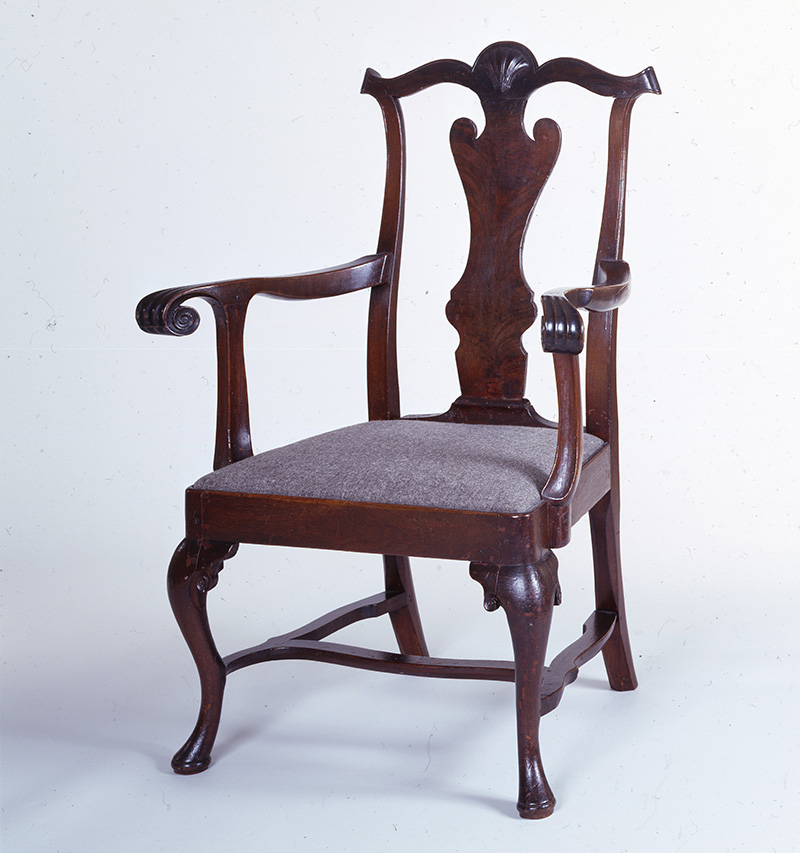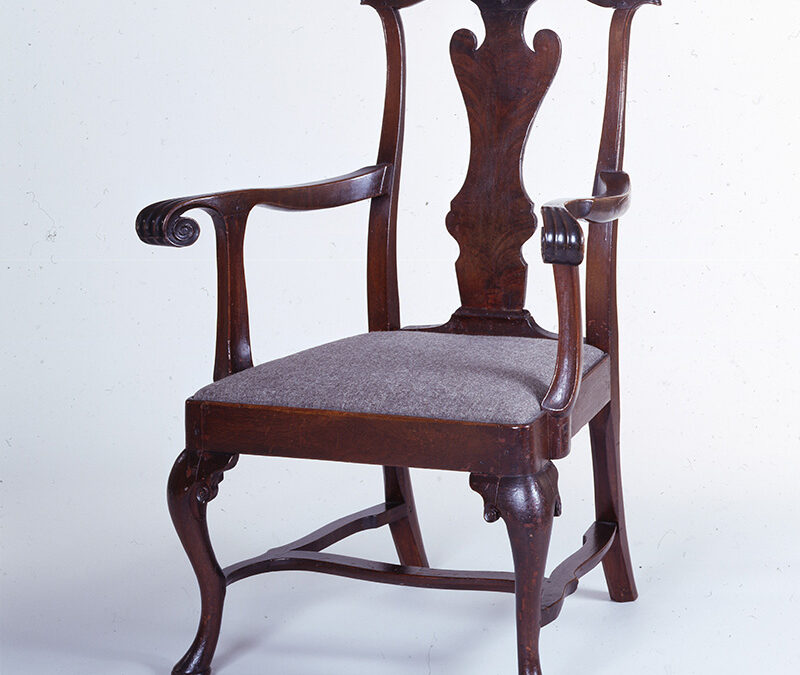Armchair

| Maker | Unknown |
| Date of Creation | Late 1740s–1765 |
| Location | Delaware |
| Materials | Walnut |
| Institution | Biggs Museum of American Art |
| Credit Line | Gift of the Estate of Sewell C. Biggs |
| Accession Number | 1992.94.1 |
| Photo Credit | Carson Zullinger |
This armchair and a related set of six side chairs descended in the Loockerman family of Dover, DE. It is probably the set of “6 old Leather Bottomed Walnut Chairs @6/, 1 Arm’d ditto @10/” in the household inventory of Vincent Loockerman taken September 7, 1785. Mention of leather bottoms identifies how the slip seats were upholstered. The inventory description of the chairs as old is consistent with the solid splat, stretchers, and early style ringed-pad foot. They were listed in the parlor along with “6 Mahogany Chairs with Damask Bottoms @42/6” and “1 Ditto Arm Ditto @60/” (now in the collection of the Diplomatic Rooms, Department of State). The presence of the ears on these chairs suggests that they probably were not made much before 1750 at the earliest. Several features distinguish these chairs from Philadelphia models. The splat ears, outlined in a conventional bead, are almost horizontal rather than angled upward. The splat imitates urban examples but has a particularly broad lower mass and high ears. The edges are only slightly chamfered, in contrast to the nearly usual practice of cutting deep chamfers to produce a sharp line at the edge and to eliminate any sense of depth of the splat. The stretchers are chamfered. The inside curve of the front legs is angular, imparting an animalistic quality to the “horse-bone” feet. The rear legs, which exhibit typical through tenons, are rounded across the back (i.e., in section) and chamfered on the inside corners. The arms and arm supports follow Philadelphia conventions but are thin and stiff. The large, scrolled handgrips are curiously angled compared to contemporary examples. Each side chair is numbered consecutively from I to VI on the front seat rail in the usual location. The same number also appears on the undersides of all four rails and the medial stretcher, probably to help the maker identify correct parts of the six chairs during fitting and assembly.
The first Loockerman in America, Govert (1633 to 1670 or 1671), worked as the American agent for an Amsterdam trading operation. Capitalizing on the heady growth of 17th-century New Amsterdam, he died one of America’s wealthiest merchants. His son, Jacob (1652-1730), followed the promise of tobacco profits south to the eastern shore of the Chesapeake Bay. In the next generation, as economic conditions began to favor cereal grains over tobacco, one of Jacob’s younger sons, Nicholas Loockerman (1697-1771), left Maryland for Kent County, DE. There, land was readily available and the soil not yet exhausted. As the first of three generations that would call central Delaware home, Nicholas created a virtually self-sufficient plantation on the foundation of which his son, Vincent Loockerman, Sr. (1722-85), operated a lucrative mercantile business, inhabited a substantial townhouse and acquired the finest decorative arts he could afford. His son, Vincent Loockerman, Jr. (1747-90) returned to the rural plantation life of his grandfather, but like his father, continued to use material culture to communicate his wealth and lengthy American pedigree. The unique material choices made by each generation reflected that generation’s local social aspirations as well as the emerging colonial trading networks that linked the increasing demand of rural Dover to the expanding supply of luxury goods from across the Atlantic world. (Laprad, 2010)
The 1730 Loockerman Hall is located on the campus of Delaware State University at Dover. It was the first building on the campus of the Delaware State College, originally established as the State College for Colored Students by an act of the Delaware General Assembly on 15 May 1891. Therefore, it is associated with the founding of Delaware’s efforts to provide higher education for its African-American students.

